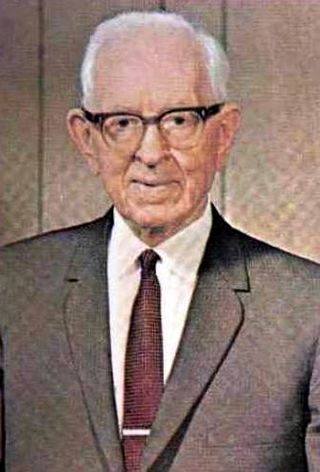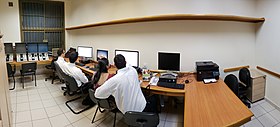
Payson is a city in Utah County, Utah, United States. It is part of the Provo–Orem Metropolitan Statistical Area. The population was 21,101 at the 2020 census.

The FamilySearch Library (FSL), formerly the Family History Library, is a genealogical research facility in downtown Salt Lake City. The library is open to the public free of charge and is operated by FamilySearch, the genealogical arm of the Church of Jesus Christ of Latter-day Saints.

Thomas Spencer Monson was an American religious leader, author, and the 16th President of the Church of Jesus Christ of Latter-day Saints. As president, he was considered by adherents of the religion to be a prophet, seer, and revelator. Monson's early career was as a manager at the Deseret News, a Utah newspaper owned by the LDS Church. He spent most of his life engaged in various church leadership positions and public service.
A stake is an administrative unit composed of multiple congregations in certain denominations of the Latter Day Saint movement. The name "stake" derives from the Book of Isaiah: "enlarge the place of thy tent; stretch forth the curtains of thine habitation; spare not, lengthen thy cords, and strengthen thy stakes". A stake is sometimes referred to as a stake of Zion.

Joseph Fielding Smith Jr. was an American religious leader and writer who served as the tenth president of the Church of Jesus Christ of Latter-day Saints from 1970 until his death in 1972. He was the son of former church president Joseph F. Smith and the great-nephew of Church founder Joseph Smith.

Temple Square is a 10-acre (4.0 ha) complex, owned by the Church of Jesus Christ of Latter-day Saints, in the center of Salt Lake City, Utah. The usage of the name has gradually changed to include several other church facilities that are immediately adjacent to Temple Square. Contained within Temple Square are the Salt Lake Temple, Salt Lake Tabernacle, Salt Lake Assembly Hall, the Seagull Monument, and two visitors' centers. The square was designated a National Historic Landmark District in 1964, recognizing the Mormon achievement in the settlement of Utah.
FamilySearch is a nonprofit organization and website offering genealogical records, education, and software. It is operated by the Church of Jesus Christ of Latter-day Saints, and is closely connected with the church's Family History Department. The Family History Department was originally established in 1894, as the Genealogical Society of Utah (GSU); it is the largest genealogy organization in the world.
This is a timeline of major events in Mormonism in the 20th century.

The Joseph Smith Memorial Building, originally called the Hotel Utah, is a social center located on the corner of Main Street and South Temple in Salt Lake City. It is named in honor of Joseph Smith, the founder of the Latter Day Saint movement. It houses several restaurants and also functions as a venue for events. Several levels of the building also serve as administrative offices for the Church of Jesus Christ of Latter-day Saints departments such as FamilySearch. On January 3, 1978, it was added to the National Register of Historic Places as the Hotel Utah.

The Allen County Public Library (ACPL) is a public library system located in Fort Wayne, Allen County, Indiana, United States. Founded in 1895 as the Fort Wayne Public Library, the library served residents with 3,606 books out of a single room in City Hall. Today the library system includes a main library and 13 branch libraries in Fort Wayne and throughout the county. The 367,000 square feet (34,100 m2) Main Library Branch in downtown Fort Wayne is home to the Fred J. Reynolds Historical Genealogy Department which holds the largest public genealogy collection in the United States.
Granite Mountain is a mass of solid rock one mile up Little Cottonwood Canyon in the Wasatch Range of Utah, not too far from Salt Lake City, Utah. Despite its name, Granite Mountain is primarily composed of quartz monzonite, an igneous rock similar to granite in appearance, physical characteristics, and chemical composition. This is the same material used to construct the Salt Lake Temple and the facade of the LDS Conference Center.

The BYU Family History Library (FHL) is located in the Harold B. Lee Library (HBLL) on the campus of Brigham Young University in Provo, Utah. It is one of the Family History Centers devoted to assisting library patrons in genealogical research. It began as a small section of the BYU library in 1962, and later expanded into a branch of the Family History Library, the genealogical library of the Church of Jesus Christ of Latter-day Saints, in 1964. It was formerly known as the Utah Valley Regional Family History Center. The BYU FHL houses a large collection of physical materials, such as microfilms, photographs, books, and other documents. It also offers access to digital materials, including genealogical databases and digitized newspapers. Scanners, computers, and printers are also available. The BYU FHL assists patrons online through its website, YouTube channel, and hosted webinars. It also offers classes in a variety of areas related to genealogy.
Archibald Fowler Bennett was a longtime employee of the Genealogical Society of Utah who was such a figure in the promotion of family history research in the Church of Jesus Christ of Latter-day Saints that he became known as "Mr. Genealogy".

Theodore Moyle Burton was a general authority of the Church of Jesus Christ of Latter-day Saints and one of the main leaders of the Genealogical Department of the church in the 1960s. Under his direction the department expanded its operations, largely through the opening of many more Family History Centers.

The Church History Library (CHL) is a research center and archives building housing materials chronicling the history of the Church of Jesus Christ of Latter-day Saints. The library is owned by the Church and opened in 2009 in downtown Salt Lake City, Utah.
Richard Eyring "Rick" Turley Jr. is an American historian and genealogist. He previously served as both an Assistant Church Historian of the Church of Jesus Christ of Latter-day Saints and as managing director of the church's public affairs department.

The Church of Jesus Christ of Latter-day Saints in California refers to the Church of Jesus Christ of Latter-day Saints and its members in California. California has the 2nd most members of the LDS Church in the United States, behind Utah. The LDS Church is the 2nd largest denomination in California, behind the Roman Catholic Church.
Lynn Mathers Hilton was an American politician who served as a member of the Utah State Legislature. He was also known as an academic professor, businessman, Middle East explorer and author of many books related to the Church of Jesus Christ of Latter-day Saints.

The Church of Jesus Christ of Latter-day Saints had a presence in Russia before the rise of the USSR, with the first baptisms occurring in 1895. Preliminary missionary efforts began before the dissolution of the Soviet Union, and the Russian government officially recognized the church in 1991. Membership increased in the 1990s and early 2000s. Missionary efforts were impacted by the 2016 Yarovaya law, which prohibited proselytizing outside of official church property. Current membership statistics are not available for Russia, but the church reported 19,946 members in 2009. As of February 2023, there were three stakes and three missions in Russia. In 2018, Russell M. Nelson announced that a temple would be constructed in a major city in Russia.

The Church of Jesus Christ of Latter-day Saints in Wales refers to the Church of Jesus Christ of Latter-day Saints and its members in Wales.















